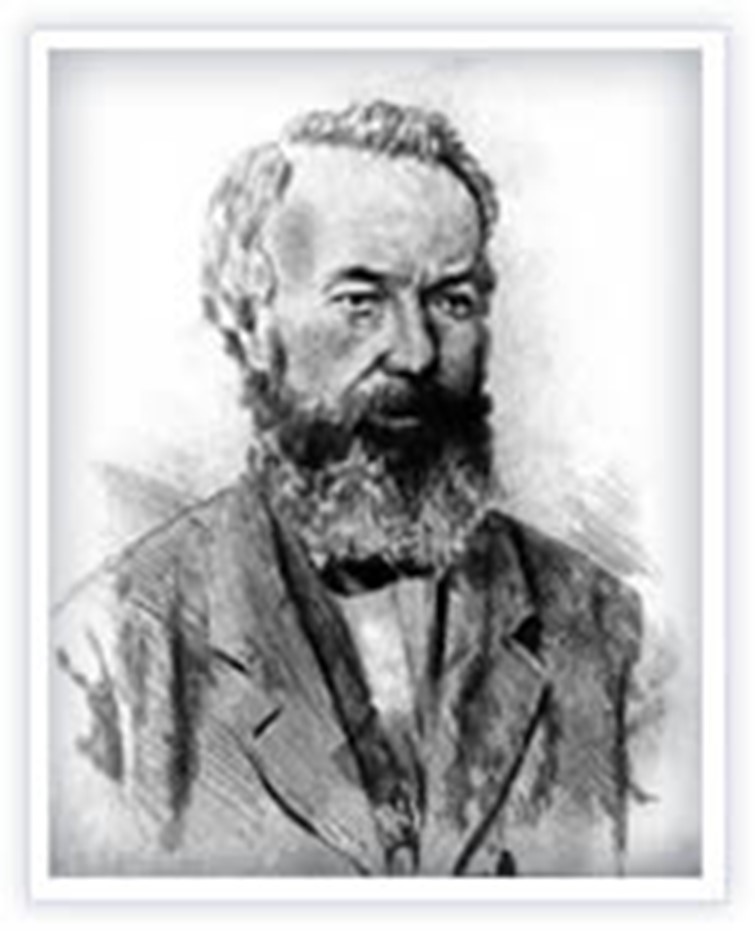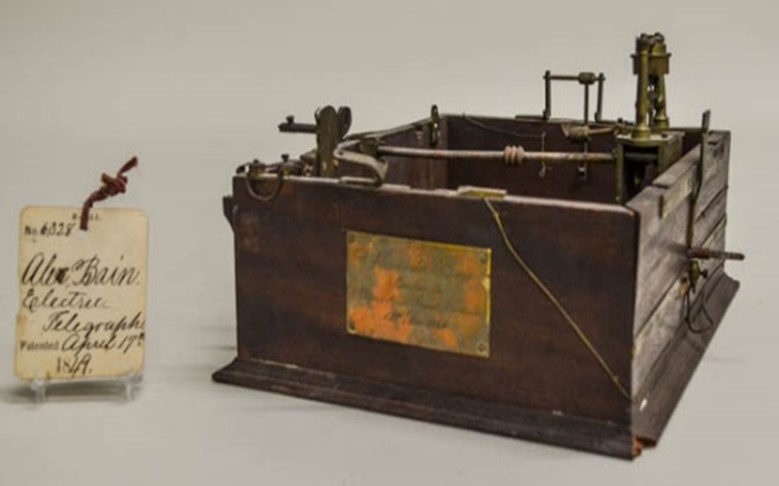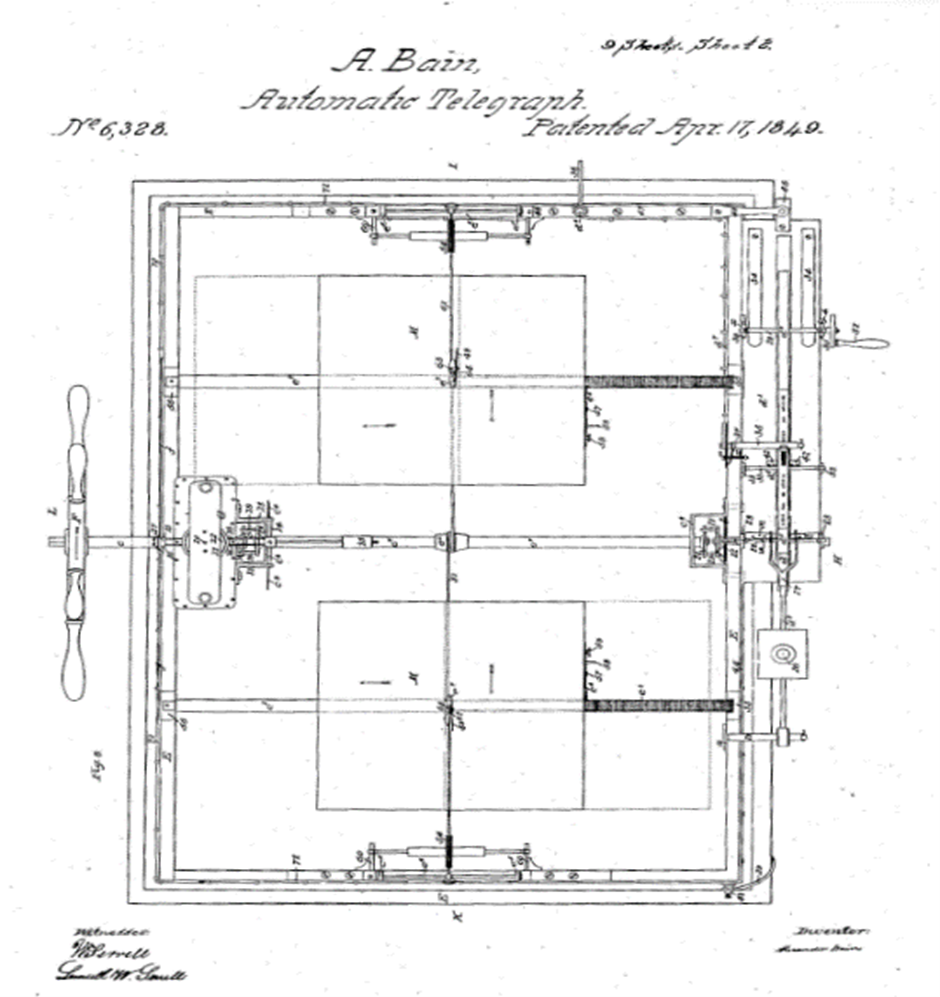When do you think the fax machine was invented? Would you be surprised to hear it was way back in the 1840s?
What’s more surprising for me was discovering the lost patent model for that invention in our collection and learning of the landmark U.S. Supreme Court case that helped spur the modern Information Age.

First, a little bit about the fax machine’s inventor, Alexander Bain (see right). Born in Scotland and apprenticed to a watchmaker in Glasgow, Bain became fascinated by electricity’s potential. Among other inventions, he developed the first electric clock and a system for synchronizing those clocks via telegraph signals to enable railroads to run on a reliable schedule.
Bain also experimented with telegraphy and discovered a unique method for recording messages. On early telegraph machines, an operator had to listen for the clicks representing the dots and dashes of Morse code and write down the message. Bain found that the same pulses of electricity representing the code could print a character on chemically treated paper. This discovery was the ancestor of that indispensable tool of late-twentieth century offices, the facsimile machine (fax).
With that in mind, you can imagine my delight when I recently unpacked a model with an engraved brass tag that read “Alexander Bain.” I was holding in my be-gloved hands the first fax machine patented in the United States!
Wait. This machine was supposed to be at the Smithsonian Institution. How could both Hagley and the Smithsonian have a patent model for the same invention? Turns out, the process Bain patented covered not one machine, but four.
 At a time when most patent applications were two or three pages, Bain’s covers seventeen. In it, he claimed five different improvements on four different machines: one for cutting the paper into thin strips; that punched the characters in the strips; a combination transmitter, receiver, and printer; and a transmitter for sending a single message to six different receiving stations. Hagley owns the combination transmitter/receiver/printer (see right), and the Smithsonian has the transmitter for sending multiple copies. Sadly, the other two machines are lost.
At a time when most patent applications were two or three pages, Bain’s covers seventeen. In it, he claimed five different improvements on four different machines: one for cutting the paper into thin strips; that punched the characters in the strips; a combination transmitter, receiver, and printer; and a transmitter for sending a single message to six different receiving stations. Hagley owns the combination transmitter/receiver/printer (see right), and the Smithsonian has the transmitter for sending multiple copies. Sadly, the other two machines are lost.
You may be wondering if fax machine technology was available in the 1840s, was it ever used? Yes! As demand for telegraphs exploded in the U.S., Bain traveled to America to seek his fortune in 1848. Samuel Morse controlled the telegraph industry at the time by issuing licenses for his 1840 U.S. patent (#1,647). Bain applied for his own U.S. patent, submitting both the Hagley and the Smithsonian models as part of the process. Though Bain’s “chemical telegraph” used different technology than his own system, Morse campaigned against it. At first, Bain was denied his patent, but he later won on appeal.

With patent in-hand, Bain partnered with Henry O’Reilly, who installed Bain’s machine at his telegraph stations on multiple lines. But Morse was not going to sit idly and yield market share. He sued O’Reilly, naming Bain in the suit. Morse’s goal was to not only shut down O’Reilly’s telegraph operation but also discourage future challengers. Morse boldly claimed the right to send messages over long distances via electromagnetic current—regardless of the machine or process that transmitted or received the message.
The O’Reilly v. Morse case eventually wound its way to the U.S. Supreme Court, resulting in a victory for Morse. This landmark 1854 decision is important for two reasons. First, it declared that Morse was the inventor of the telegraph. This is why we remember Morse today instead of the countless others, like Bain, who contributed to the invention. Second, and most importantly, the court limited Morse’s claims. While the judge acknowledged he invented the telegraph, he did not have the patent rights to everything that used electricity to communicate.
Where would our modern telecommunications industry be today without this legal precedent? By allowing others to build upon the telegraph’s technology, this decision gave inventors the freedom to develop the telephone, television, and even computer software. O’Reilly v. Morse is still cited when courts are asked to determine the difference between claiming the patent on an idea or principle and patenting the technology used in its implementation.
Fighting Morse cost Alexander Bain much of his fortune. He moved to England but found little interest in his inventions. Ultimately, he returned to Scotland and worked in a watch shop near where he had started decades before. He died broken, penniless, and nearly forgotten in an invalid home in January 1877.
Chris Cascio is the Alan W. Rothschild Assistant Curator, Patent Models at Hagley Museum and Library.
